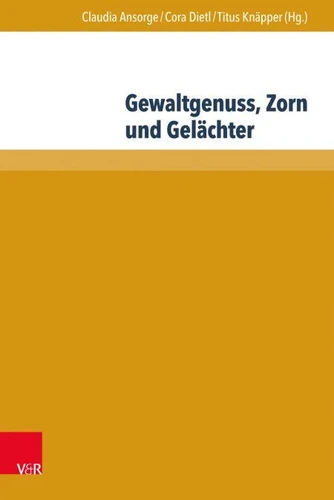Gewaltgenuss, Zorn und Gelächter. Die emotionale Seite der Gewalt in Literatur und Historiographie des Mittelalters und der Frühen Neuzeit
Par : , , ,Formats :
Disponible dans votre compte client Decitre ou Furet du Nord dès validation de votre commande. Le format PDF est :
- Compatible avec une lecture sur My Vivlio (smartphone, tablette, ordinateur)
- Compatible avec une lecture sur liseuses Vivlio
- Pour les liseuses autres que Vivlio, vous devez utiliser le logiciel Adobe Digital Edition. Non compatible avec la lecture sur les liseuses Kindle, Remarkable et Sony
 , qui est-ce ?
, qui est-ce ?Notre partenaire de plateforme de lecture numérique où vous retrouverez l'ensemble de vos ebooks gratuitement
Pour en savoir plus sur nos ebooks, consultez notre aide en ligne ici
- Nombre de pages181
- FormatPDF
- ISBN978-3-8470-0257-4
- EAN9783847002574
- Date de parution17/06/2015
- Protection num.pas de protection
- Taille1 Mo
- Infos supplémentairespdf
- ÉditeurV&R Unipress
Résumé
Violence and the escalation of violence are often linked with emotion and passion. Emotions function to prepare, stir and perform violence, which again stimulates emotions and might lead to a loss of control and (in the case of collective violence) to an intensified coherence of the violent community. Literary or historiographic texts that depic collective violence, functionalise the factor "emotions" in different ways, depending on the respective context: They might serve at justifying violence, or making it plausible, at condemning it, or making it more comprehensible or even enjoyable.
This is true both for modern and older accounts. The essays that are collected in the present volume are presented by members of the Giessen research group Communities of Violence and their guests. They ask whether there are perspectives of the emotional side of violence which are specific for certain epoques, and anyalyse medieval and early modern depictions of emotional acts of violance, with a special focus on their contexts, their messages and their aesthetic of reception.
This is true both for modern and older accounts. The essays that are collected in the present volume are presented by members of the Giessen research group Communities of Violence and their guests. They ask whether there are perspectives of the emotional side of violence which are specific for certain epoques, and anyalyse medieval and early modern depictions of emotional acts of violance, with a special focus on their contexts, their messages and their aesthetic of reception.
Violence and the escalation of violence are often linked with emotion and passion. Emotions function to prepare, stir and perform violence, which again stimulates emotions and might lead to a loss of control and (in the case of collective violence) to an intensified coherence of the violent community. Literary or historiographic texts that depic collective violence, functionalise the factor "emotions" in different ways, depending on the respective context: They might serve at justifying violence, or making it plausible, at condemning it, or making it more comprehensible or even enjoyable.
This is true both for modern and older accounts. The essays that are collected in the present volume are presented by members of the Giessen research group Communities of Violence and their guests. They ask whether there are perspectives of the emotional side of violence which are specific for certain epoques, and anyalyse medieval and early modern depictions of emotional acts of violance, with a special focus on their contexts, their messages and their aesthetic of reception.
This is true both for modern and older accounts. The essays that are collected in the present volume are presented by members of the Giessen research group Communities of Violence and their guests. They ask whether there are perspectives of the emotional side of violence which are specific for certain epoques, and anyalyse medieval and early modern depictions of emotional acts of violance, with a special focus on their contexts, their messages and their aesthetic of reception.




